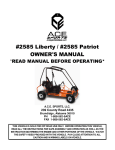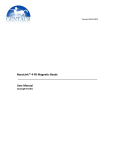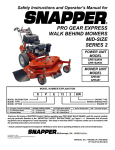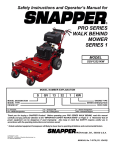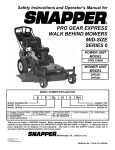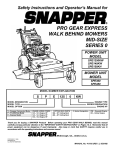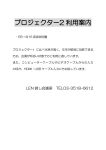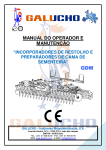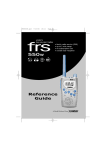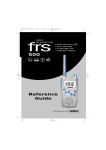Download Dyna CSADX3200 Specifications
Transcript
OWNERS MANUAL MODELS DX3200, CSADX3200 225 South Cardova Avenue Le Center, Minnesota 56057 READ AND UNDERSTAND ALL INSTRUCTIONS IN THE MANUAL BEFORE STARTING AND OPERATING THE GENERATOR SET. USING THIS MANUAL Congratulations on your choice of an ENERGX generator set. You have selected a high-quality, precisionengineered generator set designed and tested to give you years of satisfactory portable service. To get the best performance from your new engine generator set, it is important that you carefully read and follow the operating instruction in this manual. Should you experience a problem please follow the "Things To Check" near the end of this manual. The warranty in the back of this manual describes what you can expect from ENERGX should you need service assistance in the future. TABLE OF CONTENTS PAGE INTRO . . . . . . . . . . . . . . . . . . . . . . . . . . . . . . . . . . . . . .I ENERGX WARRANTY . . . . . . . . . . . . . . . . . . . . . . . . .I GUIDE TO PRODUCT SAFETY . . . . . . . . . . . . . . . . A1 BASIC INFORMATION . . . . . . . . . . . . . . . . . . . . . . . B1 Specifications.. . . . . . . . . . . . . . . . . . . . . . . . . . B1 Intended Uses . . . . . . . . . . . . . . . . . . . . . . . . . . .B1 Restricted Uses . . . . . . . . . . . . . . . . . . . . . . . . .B1 Unit Capabilities. . . . . . . . . . . . . . . . . . . . . . . . . B1 Where is Everything Located . . . . . . . . . . . . . . B2 PREPARING THE UNIT . . . . . . . . . . . . . . . . . . . . . . C1 Unpacking the unit . . . . . . . . . . . . . . . . . . . . . . C1 Oil Requirements . . . . . . . . . . . . . . . . . . . . . . . . C1 Fuel Requirements.. . . . . . . . . . . . . . . . . . . . . . C1 Battery Installation. . . . . . . . . . . . . . . . . . . . . . . C1 BASIC OPERATION . . . . . . . . . . . . . . . . . . . . . . . . . D l Initial Start Up . . . . . . . . . . . . . . . . . . . . . . . . . .D l Starting and Stopping . . . . . . . . . . . . . . . . . . . . D l Connecting the Loads.. . . . . . . . . . . . . . . . . . . D2 OPERATOR MAINTENANCE . . . . . . . . . . . . . . . . . . E l Engine Care . . . . . . . . . . . . . . . . . . . . . . . . . . . . E l Generator Care . . . . . . . . . . . . . . . . . . . . . . . . . . E l Unit Cleaning . . . . . . . . . . . . . . . . . . . . . . . . . . . E l Things to Check before you call for Service . E2 Wiring Diagram.. . . . . . . . . . . . . . . . . . . . . . . . . E3 , PROPER USE AND INSTALLATION You must be sure your new engine generator set is: * Properly serviced before starting * Operated in a well ventilated area * Exhaust gases are dispersed safely * Wired by a qualified electrician * Operated only for its designed purposes * Used only by operators who understand its operation * Properly maintained COPY YOUR MODEL AND SERIAL NUMBER HERE No other ENERGX generator has the same serial number as yours. It is important that you record the number and other vital information here, if you should ever need to contact us on this unit it will help us to respond to your needs faster. MODEL ................ SERIAL NUMBER.. ...... DATE PURCHASED . . . . . . DEALER. . . . . . . . . . . . . . . . \ GUIDE TO PRODUCT SAFETY This engine generator set has been designed and manufactured to insure your personal safety. Improper use can result in potential deadly hazards; from electrical shock, exhaust gas asphyxiation, or fire. Please read all safety instructions carefully before installation or use. Keep these instructions handy for future reference. Take special note and follow all warnings on the unit and in the manuals. CAUTION: Possible Damage to Equipment. CAUTION notes indicate any condition or practice, which if not strictly observed or remedied, could result in damage or destruction of the equipment. - 3. DEADLY EXHAUST GAS Exhaust fumes from any gasoline engine contain carbon monoxide, an odorless and deadly gas that must be mixed with fresh air. A. Operate only in well ventilated areas. B . Never operate indoors. C .Never operate the unit in such a way as to allow exhaust gases to seep back into closed rooms (i.e. through windows, walls or floors). 4. NOISE HAZARD - Excessive noise is not only tiring, but continual exposure can lead to loss of hearing. A. Use hearing protection equipment when working around this equipment for long periods of time. B. Keep your neighbors in mind when permanently installing this equipment. a WARNING: ~e'rsonalDanger. WARNING notes indicate any condition or practice, which if not strictly observed, could result in personal injury or possible loss of life. . . 1. ELECTRIC SHOCK - The output voltage present in this equipment can cause a fatal electric shock. This equipment must be operated by a responsible person. A. Do not allow anyone to operate the generator without proper instruction. B. Guard against electric shock. C. Avoid contact with live terminals or receptacles. D. Use extreme care if operating this unit in rain or snow. E. Use only three-prong grounded receptacles and extension cords. F. Be sure the unit is properly grounded to an external ground rod driven into the earth. 2. FIRE HAZARD - Gasoline and other fuels always present a hazard of possible explosion andlor fire. A. Do not refuel when the engine is running or hot. Allow the engine to cool at least two minutes before refueling. B. Keep fuel containers out of reach of children. C. Do not smoke or use open flame near the generator set or fuel tank. D. Keep a fire extinguisher nearby and know its proper use. Fire extinguishers rated ABC by NFPA are appropriate. E. Store fuel only in an approved container, and only in a well-ventilated area. 5. CLEANLINESS - Keep the generator and surrounding area clean. A.Remove all grease, ice, snow or materials that create slippery conditions around the unit. B-Remove any rags or other material that could create potential fire hazards. C .Carefully wipe up any gas or oil spills before starting the unit. D .Never allow leaves or other flammable material to build up around the engine exhaust area. 6. SERVICING EQUIPMENT - All service, including the installation or replacement of service parts, should be performed only by a qualified technician. A. Use only factory approved repair parts. B. Do not work on this equipment when fatigued. C.Never remove the protective guards, cover or receptacle panels while the engine is running. D .Use extreme caution when working on electrical components. High output voltages from this equipment can cause serious injury or death. E. When servicing this unit always avoid hot mufflers, exhaust manifolds, and engine parts. They all can cause severe burns instantly. F. Installing and wiring a home-standby generator is not a "do it yourself" project. Consult a qualified, licensed electrician or contractor. The installation must comply with all national, state, and local codes. SPECIFICATIONS MODEL Generator Surge Watts Continuous Watts AC Volts AC AMPS DC Volts DC AMPS Receptacles NEMA 5-15 (120V) NEMA 5-30 (120V) 12 Volt DC Engine Size Model TYpe Fuel Capacity Fuel Consumption full Load Starting System Stop System Low Oil Shutdown Muffler Complete Unit Weight (dry) Dimensions LxWxH Owner Must Provide Fuel Oil Type Oil Capacity DX3200 CSADX3200 3200 2800 120 23.3 12 10 3200 2800 120 23.3 12 10 4 2 1 1 1 5H P 5H P FA210 FA210 See Engine For Type 3/4 GAL 3/4 GAL 0.75 glhr 0.75 glhr Recoil Switch on Engine Shroud Standard Standard Muffler with Spark Arrestor 99 LBS 24x15~14 99 LBS 24x15x14 the engine and the generator. Small compartments will also develop hot spots where there is very little air flow and may cause a fire. 3. DO NOT attempt to operate this unit at 50 cycles. These units are designed and governed to operate at 60 Cycles only. Special units are available for 50 cycle operation. UNIT CAPABILITIES 1. Generator Connections - These generators are equipped with a single output power winding. This design will give the owner full rated generator output from a SINGLE 120 volt outlet. The battery charging circuit on the DX3200 is a center tapped off the standard 120 volt winding. On the CSADX3200 the battery charging circuit is separate winding on the armature. This output is then run through a half wave bridge rectifier where the current is changed from AC to pulsing DC current. The open circuit charging voltage as measured with a DC meter or a volt-ohm meter will read approximately seven (7) volts. The peak voltage will be over 16 volts in order to charge the battery. When the generator is connected to a 12 volt battery, the battery level voltage will immediately increase about 0.5 volts showing that the battery is being charged. A DC ammeter in series with the generator output will indicate a current reading approximately equal to the DC nameplate rating if the battery is discharged. Unleaded Gasoline SAE30 SC Class. See engine manual for additional info. .64 US qt. .64 US qt. INTENDED USES 1. These engine generator sets have been designed for portable use. Receptacles are provided in the control panel on the generator for you to plug in your loads (portable appliances and tools). These generators are designed with full power capabilities. See unit capabilities for further explanation. 2. These units require large quantities of fresh air for cooling of both the engine and the generator. Fresh air is drawn from both the engine end and the generator end and is exhausted at the center of the unit. For safety, long life and adequate performance, these units should never be run in small compartments without positive fresh air flow. RESTRICTED USES 1. DO NOT remove from the cradle assembly. Removal of the generator from the cradle assembly. may cause excessive vibration and damage to the engine generator set. 2. DO NOT install and operate these portable generators in small compartment. (i.e. generator compartment of vehicles, motor homes or travel trailers) These compartments will not allow enough free flow fresh air to reach the engine generator set for cooling and will allow the unit to overheat damaging both FIG B1 The following currents (measured in amps) are produced at 120 volts and 240 volts for models shown. AMPS @ 120 VOLT RECEPTACLE ID MODEL DX3200 CSADX3200 23.3 12 VOLT '"' SPECIFICA TlONS (continued) 2. Starting Electric Motors - Electric motors require much more current (amps) to start them than to run -them. Some motors, particularly low cost split-phase motors are very hard to start and require 5 to 7 times as much current to start them as to run them. Capacitor motors are easier to start and usually require 2 to 4 times as much current to start them as to run them. Repulsion Induction motors are the easiest to start and usually require 11/2 to 2% times as much current to start them as to run them. Most fractional horsepower motors take about the same amount of current to run them whether they are of Repulsion-Induction (RI), Capacitor (Cap), or Split-Phase(SP) type. The chart below shows the approximate current required to start and run various types of sizes of 120 volt 60 cycle electric motors under average load conditions. RUNNING STARTING AMPS RI SP CAP HP AMPS 116 3.2 16 TO 22 6 TO 13 5 TO 8 114 4.5 22 TO 32 9 TO 18 7 TO 12 113 5.2 26 TO 35 10 TO 21 8 TO 17 112 7.2 NOT MADE 14 TO 29 11 TO 18 1 13.0 NOTMADE26TO52 20TO33 The figures given above are for average loads such as a blower or fan. If the electric motor is connected to a hard starting load such as an air compressor, it will require more starting current. If it is connected to a light load, or no load such as a power saw, it will require less starting current. The exact requirement will also vary with the brand or design of the motor. 3. Motor Starting Capacity - listed below you will find the motor starting capability of your engine generator set. Model CSADX1000 (code "G" capacitor start) HP Trying to start a larger motor or a higher code (ie. J or K) motor may result in damage to both the generator and the electric motor especially 120 volt motors. WHERE IS EV'ERYTHING LOCATED L 0 - 1. 2. 3. 4. 5. 6. 7. 8. Rewind Start Grip Fuel Fill Choke Lever Air Filter Stop Switch Muffler Spark Plug 120 Volt Duplex Receptacle 9. 10. 11. 12. Ground Lug Circuit Breaker Battery Charging Receptacle Low Oil Sensor *Oil Fill Same Location Opposite Side 13. Oil Drain Plug 14. Low Oil Control Module PREPARATION INSTRUCTIONS ]-[ OUT OIL. Failure to maintain the engine UNPACKING - When you unpack your new ENGINE GENERATOR be sure to remove all the information sheets and manuals from the carton. Also be sure that any accessories (such as battery rack) ordered with the generators have also been received. 1. This power plant was in good order when shipped. Inspect the power plant promptly after receiving it. If damage is noted, notify the transportation company immediately; request proper procedures for filing a "concealed damage" claim. Title to the equipment and responsibility forfiling claim rests with you when a generator is sent F:O.B. shipping point. Only you the customer, can legally file a claim. 2. Before proceeding with the preparation of your new engine generator set for operation, take a few minutes to insure that the unit you have received is the correct model and review the specification pages in this manual to insure that this unit meets your job requirements. 3. After removing the engine generator from the carton locate and install the four rubber feet shipped loose. The cradle has been predrilled for the installation of these rubber feet. UNlT PREPARATION - Before your engine generator was shipped from our factory it was fully checked for performance. The generator was load tested to its full capacity, and the voltage and frequency were carefully checked and adjusted. 1. Lubrication - Before starting the engine, fill the crankcase to the proper level with a good quality oil. The recommended grade of oil and quantity of oil required is listed in both the engine operators manual and in the specifications section (page B1) of this manual. The importance of using the correct oil, and keeping the crankcase full cannot be overemphasized. Engine failures resulting from inadequate or improper lubricant are considered abuse and are not covered by Energx or the engine manufacturer's warranty. 2. Gasoline fuel - When using gasoline always use a good grade of unleaded fuel. Leaded gasoline may be use if unleaded is not available. Gasoline containing alcohol, such as gasohol is not recommended. However if gasoline with alcohol is used, it must not contain more than 10 percent Ethanol and must be removed from the engine during storage. DO NOT use gasoline containing methanol. Always insure that the fuel is clean and free of all impurities. - a FIRE DANGER Gasoline and its fumes are VERY explosive when proper precautions are not taken. Never use gasoline that has been stored for an extended period of time as the fuel will lose its volatile properties and you will be left with only the varnish residue. This varnish like substance will clog the carburetor and will not burn properly. The use of a fuel additive, such as STA-BIL, or an equivalent, will minimize the formation of fuel gum deposits. If a unit has been out of operation for an extended period of time its best to drain old fuel from the engine and replace with fresh fuel before attempting to start. BASIC OPERATION - INITIAL START UP - Use the following checklist to verify the correct preparation of your engine generator before starting. On All Units Check: 1. Engine oil, fill as required with correct grade and quantity. 2. Check fuel level and fill as required with clean fresh fuel. 3. Visually check unit for loose parts. added to gasoline in the fuel tank of the engine, or to gasoline in a storage container. 1. Remove the remaining fuel from the fuel tank. 2. Start the engine and allow it to run until all the fuel in the carburetor and the fuel lines has been used up and the engine stops. 3. While the engine is warm drain oil and refill with fresh oil. 4. Remove the spark plug, pour approximately 112 ounce (15 cc) of engine oil into the cylinder and crank slowly to distribute oil. Replace spark plug. 5. Clean dirt and chaff from cylinder, cylinder head fins, blower housing, rotating screen and muffler areas. Store in a clean and dry area. STARTING AND STOPPING - The throttle control on these generators is preset and locked to operate at 3600 RPM (nominal) with no load speed set at 3690 RPM. Only a trained service technician should be allowed to adjust this speed setting. See "Operating Speed" section for additional information. 1. Manual starting - Refer to the engine manual for additional starting, operating, and stopping instructions. A. Turn the stop switch to run. B. Move the choke to the full on position. A warm engine will require less choking than a cold engine. C. Grasp starter grip and pull slowly until starter engages, then pull cord rapidly to overcome compression, prevent kickback and start the engine. Repeat if necessary. D. When the engine starts, open the choke gradually. E. The engine should promptly come up to operating speed. OPERATING SPEED -The engine-generator must be run at the correct speed in order to produce the proper electrical voltage and frequency. A 1. All engines have a tendency to slow down when a load is applied. The governor on the engine is designed to hold the speed nearly constant. When the electrical load connected to the generator is increased, the engine is more heavily loaded, and as a result the speed drops slightly. This slight decrease in speed, together with the voltage drop within the generator itself, results in a slightly lower voltage when the generator is loaded to its full capacity than when running no load. The slight variation in speed also affects the frequency of the output current. This frequency variation has no appreciable effect in the operation of motors, lights and most appliances. However, electronic equipment and clocks will be affected if correct RPM is not maintained. See load vs. Output chart. Although individual units and models may vary slightly, the normal voltage and frequency of the engine-generatorsdescribed in this book are approximately as follows, under varying loads: 2. Starting Hints A. Cold weather 1. Be sure to use the proper oil for the temperature expected. 2 .A warm battery has much more starting capacity than a cold battery. 3.Use fresh winter grade fuel. Winter grade gasoline has higher volatility to improve starting. Do not use gasoline left over from summer. 4. A slightly richer fuel mixture will usually improve cold starting. B. Hot weather 1. Be sure to use the proper oil for the temperature expected. 2. Use only summer blended gasoline. Using gasoline left over from winter may cause the unit to vapor lock, because of the higher volatility of the winter fuel. 3. Do not over-choke the unit. - The output voltage should be checked to insure the generator is working properly prior to connecting a load to the generator. Failure to do so could result in damage to equipment plugged into the unit and possible injury to the individual. I LOAD vs. OUTPUT Generator Frequency Speed Applied* Half 3600 60.0 3510 58.5 *Portion of plant's rated output current. I Full 3. Stopping and Storage A. For gasoline units turn the stop switch to stop. B. Before extended storage (over 30 days) certain precautions must be taken to ensure the fuel doesn't deteriorate and clog the fuel system. Note: The use of fuel additive, such as STA-BIL, or an equivalent, will minimize the formation of fuel gum deposits during storage. Such an additive may be Voltage Recpt. 120V 115V 2. The speed of the engine was carefully adjusted at the factory so that the generator produces the proper voltage and frequency. For normal usage, the speed setting should not be changed. If the generator is being run continuously on a very light load, it is often advisable to lower the operating speed Dl BASIC OPERATlON (continued) slightly. Whenever making any speed adjustments check the unit with a voltmeter or tachometer and be sure the speed is neither too high or low. The engine must be run at the specified speed at all times. Lower voltage may damage both the generator and any load connecting to it. Running the engine at excessively high speeds results in high voltage, which may significantly shorten the life of appliances being used. 3.Output voltage should be checked periodically to ensure continued proper operation of the generating plant and appliances. If the generator is not equipped with a voltmeter, it can be checked with a portable meter. Frequency can be checked by using an electric clock with a sweep second hand. Timed against a wrist watch or a stop watch the clock should be correct within 1- 2 seconds. + CONNECTING THE LOADS 1. Applying The Load -Allow the engine to warm up for two or three minutes before applying any load. This will allow the engine to reach normal operating temperature and oil to circulate throughout the engine. A short warm-up time will permit the engine to work more efficiently when the load is applied and will reduce the wear in the engine, extending its life. A. Receptacles have been provided on the control panel for your load connections. The loads should be applied gradually. If a large motor is being started or multiple motors are being started, they should be started individually and the largest should be started first. B. Most electric tools and appliances will have the voltage and amperage requirements on their individual nameplates. When in doubt consult the manufacturer or a local electrician. The nameplate amperage rating for electric motors can be misleading, see Starting Electric Motors in section B. C.These engine generator sets are inherently self regulating based on engine speed. The engine governor will automatically adjust itself to the load. No harm to the generator will result if it is run with no load connected. D. Proper utilization of the receptacles located on the control panel is necessary to prevent damage to either the receptacles or the generator. The generator is a limited source of electrical power, therefore pay special attention to the receptacle and generator ratings. The nameplate rating can be obtained through a combination of receptacles or a single receptacle as long as the receptacle amperage rating is not exceeded. Both the 120 and 240 volt receptacles can be utilized at the same time. See section B for proper load separation. 2. Grounding - All units must be grounded. A .Drive a 3/4 or 1'' copper pipe or rod into the ground close to the engine-generator set. The pipe must penetrate moist earth. Connect an approved ground clamp, to the pipe. Run a no. 10 Awg wire from clamp to the generator ground lug or the battery negative terminal. Do not connect to a water pipe or to a ground used by a radio system. 3. Connecting the Battery - Enclosed with your new generator set you will find a 12V DC connector, leadwire and battery clip assembly. This lead wire set is provided for your use in charging 12 volt batteries. Located on the front panel is a 12 volt receptacle. To charge your batteries plug the lead wire assembly into this receptacle and attach the battery clips to the battery. The red clip is positive and the black clip is negative. If the positive and negative leads are accidentally shorted, or are incorrectly connected to the battery, the automatic resetting DC circuit breaker in the generator will trip to protect the generator and your battery. Once the short is removed the circuit breaker will reset itself in about 5 seconds. A PERSONAL DANGER Lead acid batteries produce explosive hydrogen gas when charging. Keep sparks, flames, and burning cigarettes away from the battery. Ventilate the area when charging or using the battery in an enclosed space. Lead acid batteries contain sulfuric acid, which causes severe burns. If acid contacts eyes, skin or clothing, flush well with water. For contact with eyes, get immediate medical attention. LOW OIL SHUTDOWN SYSTEM KAWASAKI Powered Generators - These engine generator sets come equipped with a standard Kawasaki low oil shut-down system. A.This low oil shut-down system will automatically stop the engine well before the oil level reaches a danger point. This feature is designed to prevent costly repairs and downtime. B.The low oil shut-down system consists of a float switch and a low oil module to monitor the oil level in the crank case. The float switch is mounted in the engine crank case between the engine and the generator end bracket. The module is mounted on the engine. The module monitors the oil level via the float switch; if the oil level is low it will short out the engine ignition and shut the engine off. If the oil level is low when the engine is started, the engine will start and run for about three (3) seconds and shutdown. This indicates that the oil level is low and must be completely refilled before starting. C. Use of this low oil shut-down system on applications that are subject to shock, bumping or severe angles of operation (in excess of 15 degrees) should be avoided. This is especially true if an unexpected shutdown would cause a safety hazard or serious inconvenience for the operator. To disable the shutdown system disconnect the wire running from under the engine shroud to the control module mounted on the engine. OPERATOR CARE AND MAINTENANCE - ENGINE CARE - If major engine service or repair is required contact an Authorized Engine Service Center. The manufacturer of these engines has established an excellent world-wide engine service organization. Engine service is very likely available from a nearby authorized dealer or distributor. Check the yellow pages of your local telephone directory under "EnginesGasoline" for the closest engine repair center or ask the dealer from whom you purchased the power plant. 1. Oil Changes Change the oil after the first 20 hours of operation and every 100 hours thereafter under normal operating conditions. Change engine oil every 50 hours of operation if the engine is operated under heavy load, or in high ambient temperatures. A. Remove oil drain plug at base of the engine and drain the oil with the engine warm. B. Replace oil drain plug. C .Remove oil filler plug and refill with new oil. Refer to the table in the engine manual for the proper grade of oil based on your operating temperature. D. Replace filler plug. - 2.Checking the Oil Level. The oil level must always be checked before the engine is started. Take care to remove any dirt or debris from around the oil fill plug before removing. Be sure the oil level is maintained. FILLTO POINT OF OVERFLOWING or on units with the extended oil fill to the "FULL" mark on the dipstick. If the engine generator should fail to start and run, check to be sure that the low oil protection system has not been activated by a low oil condition. 3. Servicing Air Cleaners A .Cleaning Air Cleaner Element - clean and re-oil foam air cleaner at three month intervals or every 50 hours, which ever occurs first. Service more often under dusty conditions. 1. Remove air cleaner cover and take the element out. 2. Wash element in kerosene or liquid detergent and water. 3. Wrap foam pre-cleaner in cloth and squeeze dry4 . Saturate in engine oil. Squeeze to remove excess oil. 5. Install element in the air cleaner body. Be sure to install with the surface marked "inside" facing toward the carburetor. 4. Spark Plug - Clean and reset gap at .030" every 100 hours of operation. Do not blast clean spark plug. Clean by scraping or wire brushing and washing with a commercial solvent. Poor spark will occur if terminal does not fit firmly on spark plug. If this happens re-form the terminal to fit firmly on spark plug tip. GENERATOR CARE - Proper care and maintenance of the generator is necessary to insure a long trouble free life. 1. Exercising The Generator - The generator should be operated every three to four weeks. It should be operated for a period of time sufficient to warm the unit up and to dry out any moisture that has accumulated in the winds. If left this moisture can cause corrosion in the winding and on the slip rings. Frequent operation of the engine generator set will also insure that the set is operating properly should it be needed in an emergency. 2. Generator Maintenance - Any major generator service including the installation or replacement of parts should be performed only by a qualified electrical service man. USE ONLY FACTORY APPROVED REPAIR PARTS. A. Bearing - The bearing when used in these generators is heavy duty double sealed ball bearing. It requires no maintenance or lubrication. B. Brushes - Under ordinary circumstances brushes will operate for long periods without requiring replacement. They should be inspected after 1000 hours of operation and every 100 hours thereafter. When operating in dusty conditions check more often to insure the slip ring and brush contact area is clean and not wearing excessively. C. Receptacles - Quality receptacles have been utilized. If a receptacle should become cracked or otherwise damaged, replace it. Using damaged or cracked receptacles can be dangerous both to the operator and to the equipment. CLEANING - Remove dirt and debris with a cloth or brush. DO NOT use high pressure spray to clean either the engine or the generator. This high pressure spray could contaminate the fuel system and the generator components. 1. Keep the air inlet screen on both the engine and generator free of any dirt or debris to insure proper cooling. At least yearly remove the blower housing on the engine and clean the chaff and dirt out of the engine cooling fins and flywheel. Clean more often if necessary, failure to keep these areas clean may cause overheating and permanent damage to the unit. 2. Periodically clean muffler area to remove all grass, dirt and combustible debris to prevent a fire. 3. On engine mufflers equipped with spark arresters, the spark arrester must be removed every 50 hours for cleaning and inspection. Replace if damaged. OPERATOR CARE AND MAINTENANCE (continued) - THINGS TO CHECK Sometimes problems can be easily solved by checking a few basic things. Check the chart below before you call or take your unit to a service center. It could save you time and money. Problem Won't Start Voltage too low Voltage too high Possible Causes *Check and clean spark plug *Check fuel level *Fuel turned on. Dead battery *Defective start switch. *Check for proper engine speed *Generator overloaded *Defective rectifier *Defective Armature *Defective Field Coil *Engine speed is too high Problem Generator overheating No output voltage Battery not re-charging Possible Causes *Overloaded *Insufficient ventilation *Short in load (disconnect) *No residual magnetisim in generator *Defective armature *Defective field coil *Defective Brushes *Shorted condenser *Shorted rectifier Defective receptacle *Defective charging circuit on engine EXCITATION CIRCUIT "BOOST" CIRCUIT POWER CIRCUIT BATTERY CHARGE 'FULL POWER ARMATURE WINDINGS RECEPTACLES EXCITATION ClRCUlT CAYS I - I I"," RECTIFIER 7 YRUSHES SHUNT FIELD COILS POWER CIRCUIT SLIP RINGS \ d BATTERY CHARGE & ? . CIRCUIT 'FULL POWER WINDING NEUTRAL ciln OUTPUT mnn,, BAnERY CHARGE "ECTIFIER AC 4' 120 VOLT CIRCUIT BREAKER 9 25 AMP 120 VOLT 9 CIRCUIT BREAKER + ARMATURE WINDINGS BATTERY CHARGING WINDING "tluuti I '. "BOOST" AUTO RESET CIRCUIT BREAKER N i NOT USED A - A I













